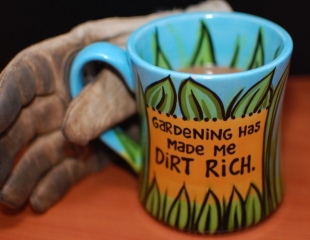Posts Tagged ‘dogwood’
The Tupelo Speaks
Once we asked a well-regarded landscape architect, Roger Washburn, to consult. It turns out we could not afford him but he was generous with his time and ideas. Among other things, he noted our stand of tupelo trees. My tree knowledge is limited so it was noteworthy to me that they were noteworthy to him.
Our tupelos stand behind the weathering Tin Man; they anchor the hanging garden mirror and, here’s the part I’m getting to — they announce the peak of summer.
The tupelos are the first to turn color and drop a leaf and they typically do so in early July, which makes sense from a plant perspective, being on the waning side of summer solstice. This year’s tupelo turn came two weeks late. What now?
Summer Harvest

Hydrangea, phlox, and echinacea with “Minuet”

Hydrangea, black-eyed susan, phlox, monarda
Our summer’s peak saw a blistering heatwave that started early and ended late. Still, the flowers were heavenly. For example, the hydrangea by the back door trellis had hundreds of blue heads, the kousa dogwood is still in bloom, the monarda and phlox are swarming with bees, hummingbirds and butterflies. The swimming pool has been our respite.
More recently degrees have ranged from low 60’s F to mid 80’s F. And rain.
When it was just too hot outside, we enjoyed the blooming harvest inside. This garden is my joy.
Dirt – A Love Story
It’s everywhere! We scrub it off our hands, our shoes, our personae. We think: clean = good, dirt = bad. Even gardeners succumb to dirt-riddance — we clean our gardens in the spring! But I’m telling you — dirt is your friend, not your enemy.
Here’s why.Get Smart – Eat Dirt!
Dirt harbors essential micro-organisms (like bacteria and fungi). “Yikes!“, you shriek, “That’s a good thing?“. Not just good, essential.
Soil scientists say each gram of soil (less than a teaspoonful) contains over 1,000,000,000 microbes (1 billion!), hosting over 10,000 different species. Here’s what some of these buggers do:
- grow our crops,
- convert wastes into compost,
- deliver vitamins to plants (in the “rhizosphere“),
- kill insects,
- consume toxic waste (like oil spills), and
- create soil in the first place
When soil is first made, for example after a volcano, some nutrients are missing, including nitrogen and carbon. Therefore, the first organisms to colonize the soil are generally nitrogen fixers and photosynthesizers that fix carbon. [DLC-ME]
Furthermore, a study conducted by researchers Dorothy Matthews and Susan Jenks at The Sage Colleges (Troy, NY) suggests that soil-borne germs play a role in reducing anxiety and enhancing learning. The study attracted lots of coverage, like “Can Bacteria Make You Smarter?” (Science Daily) and on Radio Netherlands “The Dirt Show“. Here the two researchers pose with dirt martinis (yuk!).
Anyway, get smart — eat dirt!
Dirt – Accidentally in Love
I began my wholesome relationship with dirt by accident, often the case with true love. I had planned a border along the front driveway and set to work removing a strip of sod about 2 feet wide and 80 feet long. I had loam delivered to create the bed where the sod once was. For expediency, I dumped the torn up sod in a low spot in the backyard; it formed a chunky mound on which I later dumped fall leaves and some additional loam on top to hold it all in place.
I finished the driveway border project, planting daylilies, astilbe and daffodils topped with a layer of bark mulch. Over the next couple of years I expanded the experimental mound in the backyard, adding a curved path with pea stone gravel, throwing in Bleeding Hearts, Oriental lilies, astilbe, a leftover Alberta Spruce, a red twig dogwood, Japanese dwarf spirea, ferns (etc.). What I found was — it didn’t matter what I planted there. Everything flourished. I had accidentally created a rich, organic home for my woodland plants! Dirt won me over and I’m accidentally in love!
I’ve since enlarged the accidental garden with yard clippings, chopped oak leaves, more loam, and barn “soil” from a nearby stable. In the expanded section, I added shrub roses, Columbine, an ornamental Japanese maple, American ginger, epimedium, sweet pepperbush (Clethra) and a stone wall. We’re happy together.
The Joy of Dirt
Back to the driveway border. It perennially struggles — its loamy bed dries out in summer because it doesn’t have enough organic material to store water for long. The day lilies come up OK, but they haven’t prospered; ditto the daffodils. Some day, I will re-visit this project and give it the tender lovin’ dirt it needs.
I’ve started another mound in the front yard: lawn clippings, chopped leaves, compost from the Marshfield transfer station (aka, the dump), and a decorative covering of bark mulch. It’s January and the mound is slumbering beneath a foot of snow, while microorganisms and worms are busily feeding and creating new dirt. Oh, joy!
Now it’s your turn — Share the dirt!



